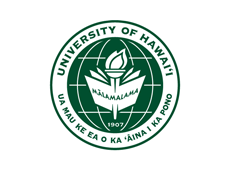University of Hawaii, Manoa
11/2003 -
10/2008
(CAN 3)
The Origin, History, and Distribution of Water and Its Relation to Life in the Universe
Intellectual Focus & Proposed Research —
Water is the medium in which the chemistry of all life on Earth takes place. Water is the habitat in which life first emerged and in which all of it still thrives. Water has modified Earth’s geology and climate to a degree that has allowed life to persist to the present epoch. We propose to create a research and education framework that links the biological, chemical, geological, and astronomical sciences to better understand the origin, history, distribution, and role of water as it relates to life in the universe. We focus on scenarios involving the sources and distribution of water in planetary systems and the delivery and incorporation of water into rocky planets that orbit within the “habitable zones” of their parent stars. Our framework will include and connect research on major aspects of planetary water – in effect we aim to understand the terms of a “watery Drake equation”:
- Observations and modeling of the abundance and distribution of water in the interstellar medium, molecular clouds, and circumstellar disks;
- Surveys and studies of the numbers, water text, D/H ratio and dynamics of icy outer solar system bodies such as comets, Centaurs and Kuiper Belt objects;
- Laboratory experiments on complex molecule trapping and formation on interstellar water-rich grain mantles and planetary ices;
- Cosmochemical studies of meteorites that record the incorporation of water into silicate material in the primordial Solar System as an early step in its eventual inclusion in larger bodies, including planets;
- Models of the escape of water (as hydrogen) from the atmospheres of Earth-sized planets;
- Spacecraft- and meteorite-based research and theoretical studies on the role of water in forming the diversity of rocks and sediments on Earth, Mars, and Venus.
- Biological exploration of ice-covered habitats in Iceland, Antarctica, and North America with potential application to the search for life on Mars and Europa.
- Biological and chemical exploration of extreme aquatic habitats in and around the Hawaiian islands including the deep-sea, Kauhako Lake crater on Molokai and Lake Waiau near the summit of Mauna Kea.
- Development of concepts and prototype hardware for instruments that could be used to detect and characterize life on other planetary bodies.
Distinguishing Features –
By developing and testing models and exploring the outcomes of alternative scenarios we seek to determine what controls the abundance and distribution of water and hypothetical aque-ous habitats in other planetary systems. This research will directly support the NASA search for past or present life on Mars and efforts (such as the NASA Terrestrial Planet Finder) to di-rectly detect and characterize Earth-sized exoplanets. The proposed framework of our research will support a group of postdoctoral scholars who will carry out independent, interdisciplinary research spanning two or more of the investigators’ (or affiliated investigators’) research special-ties. The island setting and the unique facilities of the University of Hawaii offer an environment conducive to these investigations. The University of Hawaii houses world-class research groups active in astronomy, and in the chemical, geological and biological sciences. It is home to a sub-stantial array of scientific facilities, including the telescopes of Mauna Kea Observatory, a fleet of research vessels for oceanographic and deep-sea investigations and facilities for exploration of the extreme environments found on the volcanoes and in the lakes and oceans around Hawaii. Through this Astrobiology proposal we aim to combine and capitalize on these many areas of research excellence to craft a new, interdisciplinary study of water and its relation to life.
Management Approach –
The UH-NAI PI will meet once a month with the Co-Investigators to discuss research progress, discuss any technical, financial or management issues, and to involve everyone in the E/PO ac-tivites. The timelines and status of the projects will be reviewed and updated at these meetings. In addition the UH-NAI will offer an astrobiology seminar series which will involve the entire local community. Additionally the development of our collaborative visualization tool will help foster interdisciplinary communications and highlight areas of new development which can be discussed at these regular meetings.
Education/Public Outreach Activities –
Our group has a strong record in education and public outreach, and we intend to build on that experience by providing innovative laboratory-based learning opportunities for teachers and engaging the public in our research. We intend to develop a program that trains teachers in the science of astrobiology, how to incorporate astrobiology into their classes, and in how to use the activities we will develop as part of the program. The focal point of our teacher-training program will be a summer professional development program. Using the summer workshop and research experience as a base, we will also develop a course for pre-service teachers. All projects will involve development of standards-based classroom activities. We also intend to actively engage the public in our discoveries.
Collaborative Networking Concepts –
We are developing sophisticated database web management tools to assist in the daily operations of our group. In addition, we are developing innovative collaborative networking tools across the research areas within our group to facilitate more efficient astrobiology research.

-

Karen Meech

-
Active Dates:
11/2003 - 10/2008 -
Team Website:
Coming Soon -
Members:
73 (See All) -
EMERITUS TEAMS:
2009-2015


